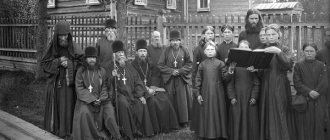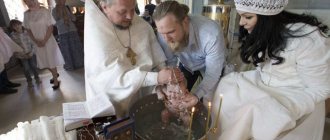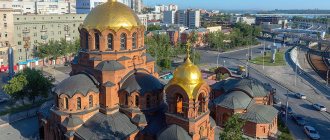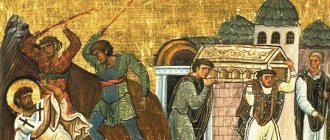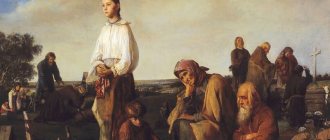Old Believers today
In recent years, an increasing number of our fellow citizens are interested in issues of a healthy lifestyle, environmentally friendly methods of farming, survival in extreme conditions, the ability to live in harmony with nature, and spiritual improvement. In this regard, many turn to the thousand-year experience of our ancestors, who managed to develop the vast territories of present-day Russia and created agricultural, trade and military outposts in all remote corners of our Motherland.
Last but not least, in this case we are talking about the Old Believers - people who at one time settled not only the territories of the Russian Empire, but also brought the Russian language, Russian culture and Russian faith to the banks of the Nile, to the jungles of Bolivia, the wastelands of Australia and to the snow-capped hills of Alaska . The experience of the Old Believers is truly unique : they were able to preserve their religious and cultural identity in the most difficult natural and political conditions and not lose their language and customs. It is no coincidence that the famous hermit Agafya Lykova from the Lykov family of Old Believers is so well known all over the world.
not much is known about the Old Believers Some people believe that Old Believers are people with a primitive education who adhere to outdated farming methods. Others think that Old Believers are people who profess paganism and worship the ancient Russian gods - Perun, Veles, Dazhdbog and others. Still others ask the question: if there are Old Believers, then there must be some kind of old faith? Read the answer to these and other questions regarding Old Believers in our article.
Old Believers
Old Believers are people who adhere to old Christian rituals. During the reign of A.M. Romanov, under the leadership of Patriarch Nikon, carried out religious reform. Those who refused to obey the new rules united and immediately began to be called schismatics, since they seemed to split the Christian faith into old and new. In 1905 they began to be called Old Believers. Old Believers became widespread in Siberia.
The main differences between the new and old rituals include:
- The Old Believers write the name of Jesus, as before, with a small letter and one “and” (Jesus).
- The three-fingered sign introduced by Nikon is not recognized by them and therefore they continue to cross themselves with two fingers.
- Baptism takes place according to the tradition of the old Church - immersion, because this is exactly how they were baptized in Rus'.
- When reading prayers according to old rituals, clothes specially designed for this purpose are used.
Old Believers—Priests
The Old Believers - priests, in addition to other church institutions, recognize the three-tier Old Believer hierarchy (priesthood) and all the church sacraments of the ancient Church, among which the most famous are: Baptism, Confirmation, Eucharist, Priesthood, Marriage, Confession (Repentance), Blessing of Anointing. In addition to these seven sacraments in the Old Belief , there are other, somewhat less known sacraments and sacred rites, namely: tonsure as a monk (equivalent to the sacrament of Marriage), the Great and Small Blessing of Water, the Blessing of Oil on Polyeleos, and the priestly blessing.
The difference between Old Believers and Old Believers
So, first we need to figure out who the Old Believers are and who are the Old Believers. Old Believers are Christians who opposed the adoption of the reforms of Patriarch Nikon. In the 50s of the 17th century, these reforms led to a split in the Russian Church, and those who refused to obey them were declared schismatics, anathematized and oppressed in every possible way. Many died, some managed to flee abroad and continue their family line there. Only in the last century did attitudes towards them soften. A decree of Tsar Nicholas II of 1905 ordered the word “schismatic” to be replaced with the neutral “Old Believer.”
And what did these people rebel against in those troubled times when Nikon split the church? In their opinion, most innovations did not correspond to the truth and desecrated it. For example:
- According to the reforms, the name of God began to be written as Jesus. And the books of old rituals included one “and” at the beginning - Jesus.
- The new canon said to cross with three fingers, and not two, as before.
- Walking around the church was now only possible (counterclockwise).
- The books of worship have undergone serious revisions. In particular, the word “devout” was replaced with “Orthodox.”
Old Believers are those who adhere to pre-Christian views of the world. It would be a big mistake to consider them some kind of ossified, unsociable people steeped in the distant past, who despise modern religion and the way of life in general. These people have a much stronger connection with nature, and their worldview is broader than that of ordinary Christians. They feel like followers of the ancient Slavs, believe in the Slavic Vedas and the special inextricable connection between man and nature. This is the fundamental difference between the Old Believers and the Old Believers, who draw a clear line between the Creator and what he created.
This is what a typical Old Believer looks like
Old Believers are convinced that only by solitude with nature, a person is able to know his true essence and the meaning of being in this world. The Old Believer calendar says that now humanity is going through the era of the Night of Svarog (Kali Yuga), one of the most difficult periods in modern history: economic crises, military conflicts, natural disasters, the triumph of giant corporations. According to the Vedas, everything that happens in the world can be explained, and nothing is accidental.
Let's understand the terminology
The distinction between such concepts as “Orthodox Church” and “Old Believers” is actually quite arbitrary. Old Believers are confident that only their faith is truly Orthodox, and the Russian Orthodox Church is classified as Nikonians or New Believers.
Even in the ancient literature of the Old Believers in past centuries there was no term “Old Believer”. They were more often called “Old Orthodox Christians” or “Old Believers.” The words “orthodoxy” and, especially, “true Orthodoxy” were also often used.
The selected documents contain the phrase “true Orthodox Church.” Only towards the end of the outgoing century did the concept of “Old Believers” reach widespread distribution. But representatives of different movements stubbornly continued to deny each other’s belonging to Orthodoxy.
In the rhythm of time
The Orthodox Old Believers were perceived by the authorities as a political movement that played the role of opposition for the imperial court. And indeed, as soon as Catherine II gave them official permission to build churches, this movement founded and organized its own city in a short period of time. Today it is located on the territory of Belarus. In the 18th century there were about 5,000 Old Believers there.
Some of these people were killed by order of the queen. All who remained alive were forcibly resettled to eastern Russia. Their descendants still live there. Today they are known under the name Semeyskie.
It should be noted that other religious minorities, from Protestants to Buddhists, received government support.
According to official sources, in the 19th century, a third of the population of the Russian Empire still lived according to the rules of their ancestors, who were baptized in Kievan Rus.
Later, the authorities began to be more loyal to this trend. The question arose more and more often: “Who are the Old Believers?” Their customs and canons were not considered as those that could damage the integrity of the state. But they were prohibited from building temples, printing books, disseminating teachings, and even holding high positions. Even marriage was illegal for couples.
At the beginning of the 1900s, the rights of this denomination were equal to those of other religious minorities.
Old Believers and Old Believers - what is the difference
Differences in the faith of Old Believers and Old Believers
Very often, Old Believers are confused with Old Believers, attributing to them the same worldview. However, there are a large number of differences between Old Believers and Old Believers. Confusion in these concepts is created by the media, which, without knowing Russian terminology, interpret the definitions with incorrect concepts.
Old Believers are the custodians of the old faith of their ancestors - the pre-Christian faith, faith in the Orthodox Vedas. Old Believers are representatives of the old Christian rite and refuse to accept the innovations of the Christian Church.
There is also a second reason why there is now confusion in the concept of Old Believers and Old Believers. In 1653, under the leadership of Tsar Alexei Romanov, church reforms were launched, which met strong resistance from supporters of the old rituals. All Old Believers were declared apostates and excommunicated from the church.
The Old Believers accepted the Old Believers into their midst and gave them shelter, perceiving the arrival of the Old Believers to them as the will of God.
The Old Believers (they are also called schismatics) were formed during the church reforms of Patriarch Nikon. The differences between the Old Believers and today's Orthodox Christians lie in a number of aspects of their service and in the writing of certain parts of the Bible.
Old Believers believe that the innovations of the Orthodox Church deeply affect the inner spiritual basis of Christianity. Old Believers are widespread in Siberia.
The faith of the Old Believers is strikingly different from the faith of the Old Believers. Old Believers firmly believe in the Slavic Vedas, the ancient Slavic faith.
According to the chronology of the Old Believers, the Night of Svarogo is now underway - the most difficult time according to Vedic knowledge, the so-called Kali Yuga according to the Indian Vedas.
The Old Believers, unlike the Old Believers, had a more extensive systemic worldview, covering various spheres of human life, because the Vedas are not a religion, but the wisest ancient knowledge about all spheres of human life.
Is it permissible for an Old Believer to become a godfather for an Orthodox Christian?
Photo: Flickr.com
This possibility should not be categorically denied, but such a situation becomes possible only if the Old Believer is only one of the godparents. The second godfather must be a representative of the modern official Orthodox Church.
Also, the Old Believer must promise that he will not make attempts to raise a baptized child in traditions that contradict the official Orthodox religion.
( 29 ratings, average: 3.93 out of 5)
Customs of the Old Believers
The Old Believers had the following customs.
Priests' baptism
Old Believers-priests can perform the sacrament of baptism, if desired, in a natural reservoir or in a font. A priest must perform the sacrament. The exception is a situation when a person is dying and is afraid to leave unbaptized, and an Old Believer priest cannot be found in the surrounding area at that moment. Then the ritual is performed by lay people.
A man plunges into clean water three times. At the first ablution, the priest says: “The Servant of God is baptized ... in the name of the Father, amen,” at the second: “and the Son, amen,” at the third: “and the Holy Spirit, amen.” Bathing in water symbolizes cleansing from sinfulness and union with God.
When baptizing a baby, it is necessary to read prayers to the mother in labor and when naming the baby. This is done so that the mother’s health is strengthened after childbirth, and the child lives her life according to her conscience and deserves the Kingdom of Heaven. On the 8th day, the rite of Confirmation should be performed on the baptized person.
Baptism among the non-priests
Among the Old Believers without priests, the sacrament of Baptism is performed in a similar way. Baptism is also permitted both in a natural reservoir and in a font.
Three immersions are performed, during which the priest pronounces a blessing. For 8 days after baptism, it is not recommended to wash the body completely and remove the shirt in which you were baptized. On the 8th day Confirmation takes place.
We advise you to study Where did the expression “Doubting Thomas” come from?
Wedding
The wedding ritual according to the old rite is noticeably different from that accepted by modern Orthodoxy. The table shows their difference.
| Old rite | New rite | |
| Reading the Apostle and the Gospel | At the beginning | After laying the crowns |
| Singing Psalm 127 | Choruses were added that were not in the old rite | |
| Questions to those getting married about the voluntariness of their intentions | No | Eat |
| Registration at the Civil Registry Office | After the wedding | Before the wedding |
| A warrior on the bride's head | Worn at the end of the engagement | Not used |
Marriage of an Old Believer couple
Funeral
It is customary among Old Believers to bury the deceased on the 3rd day. On the eve of the burial, on the morning of that day and before the burial, memorial services are held. The longer the funeral service lasts, the purer the soul will appear before God. Only those who lived their lives with dignity and righteousness deserve a funeral service.
The head of the deceased in the coffin should face west, the legs should face east. At the funeral, the last service, Lithia, is held. After it, the symbols of faith are taken out of the coffin, nailed up and lowered into the ground. Old Believers do not have a wake immediately after a funeral. They are carried out on days 3, 9 and 40 after death.
Internet, TV and medicine
It cannot be said that the Old Believers have completely dismissed the achievements of civilization and are sitting without gas, water and electricity. The Internet and television are not held in high esteem—the community leads an isolated lifestyle. The benefits of civilization, like a car or agricultural machinery, are very welcome. Another thing is that the Old Believers can get by quite easily without all these benefits (if they are absent) without falling into despondency.
They have a skeptical attitude towards traditional medicine Old Believers get sick much less often than city residents and their health is much better. of traditional medicine passed on from generation to generation are in use . Institutions are also not held in high esteem, since there is a functional approach - why bother yourself with something that is unlikely to be useful in life. The attitude towards military service is traditional - a real man must pay his debt to his homeland .
Old Believers and Old Believers: differences
The main stumbling block between representatives of the two faiths will be the difference in beliefs. Let's look at how these religious groups differ further.
- Old Believers, like ordinary Orthodox Christians, revere Christ, and Old Believers are faithful to the ancient Slavic gods: Perun, Dazhdbog, Yaril, etc.
- The source of religious wisdom for the former is the Bible, and for the latter - ethnic and folklore studies about the paganism of ancient Rus'.
- Rodnoverie is more fragmented: there are many directions, each of which worships its own group of gods. The second group is mainly centered around the Russian Orthodox Old Believer Church.
- Old Believers believe that after death, souls go to Nav to Veles, where he decides whether a person is worthy of rebirth or destruction. In the third case, having achieved enlightenment, the Rodnover goes to Iriy, where the highest gods are located. The Old Orthodox adhere to concepts about Heaven and Hell similar to the Russian Orthodox Church.
- The Rodnovers have two types of rituals: external and internal. The first are carried out in large groups, and the second - personally by an individual or several close people. They celebrate Slavic religious celebrations and keep a calendar from the founding of Slovensk the Great in 2409 BC. e. Old Believers count the years from the creation of the world and adhere to the rituals adopted before the reform of Patriarch Nikon.
Before the decree of Catherine II, Orthodox schismatics were called Old Believers. Only at the request of the tolerant empress did they receive the name Old Believers and some concessions. In the modern world, the term is applied equally to neo-pagans and ancient Orthodox, which causes confusion. Adding to the questions is the fact that some adherents of the Slavic gods mistakenly claim that the word “Orthodoxy” has Russian roots. By calling themselves in this way, they do not mean the worship of Christ, but the praise of the correct faith. The differences between the Old Believers and the Rodnovers leave no room for confusion between these two religious movements.
https://youtube.com/watch?v=TA3uIAxOV6k
Let's summarize
- In the 17th century, the Russian Orthodox Church adopted many innovations regarding rituals, the type of cross, and icons. People who did not accept these innovations began to be called Old Believers.
- Old Believers and New Believers have differences in the spelling of the name of Christ (Isus and Jesus, respectively), the method of baptism (with two and three fingers), the depth of the ritual bow, and so on.
- Old Believers recognize only the 8-pointed cross, the Orthodox - six-pointed and eight-pointed.
Isn’t it possible that the Orthodox Old Believers differ from the modern Russian Orthodox Church more than the Catholic Church?
You can learn about the main 12 differences between the classical Orthodox faith and Catholicism from this video: When using materials from thebestvideo.ru, a link to the source is required.
Appearance
The Old Believers have huge differences from the Orthodox in appearance. This manifests itself in the following:
- Men should definitely have big beards. Shaving them is strictly prohibited;
- The standard attire for a man is a large, unkempt, untucked shirt, as was worn in Rus' in ancient times;
- The shirt is complemented by a tightened belt. It is endowed with the function of dividing the body into the upper part - the spiritual, striving for the Creator - and the lower part, which symbolizes everything earthly and base;
- No bright colors in clothes! Only strict, one-color things;
- A tie is an unacceptable accessory for an Old Believer. It is associated with Judas, and that is why the tie is called Judas's noose;
- Among the Orthodox, a woman can come to church covering her head with a scarf or scarf tied in a knot. In an Old Believer church, a woman is only allowed to wear a headscarf, which is pinned under the chin.
This is what Old Believers usually look like
Why were the Old Believers called Bespopovtsy?
The split of the Old Believers formed two separate branches - priesthood and non-priesthood. Unlike the Old Believers-Priests, who after the schism recognized the church hierarchy and all the sacraments, the Old Believers-Priestless began to deny the priesthood in all its manifestations and recognized only two sacraments - Baptism and Confession.
There are Old Believer movements that also do not deny the sacrament of Marriage. According to the Bespopovites, the Antichrist has reigned in the world, and all modern clergy is a heresy that is of no use.
Old Believers: the history of the schism
In fact, the Old Believers, their customs and traditions are far from the false idea that “the Old Believers are those who still make sacrifices to Zeus and Perun.” The reason for the split at one time was the reform that Tsar Alexei Romanov and Patriarch Nikon (Minin) decided to carry out. The Old Believers and their difference from the Orthodox began with the difference in making the sign of the cross. The reform proposed changing two fingers to three fingers, abolishing prostrations; later the reform affected all forms of the Church’s charter and order of worship. Until the reign of Peter I, changes took place in church life, which the Old Believers, who valued old customs and traditions, perceived as an encroachment on the traditional and correct, from their point of view, religious order.
Archpriest Avvakum called for preserving the old faith, including the Old Believer cross, and suffering for the “old faith,” if necessary. The reform of Patriarch Nikon was not accepted in the Solovetsky Monastery either; the inhabitants of the monastery turned to Tsar Alexei Romanov with a petition in defense of the old faith. Old Believers in Russia today are followers of those who did not accept the reform in the 17th century.
What do Old Believers believe?
The Old Believers, as the heirs of pre-schism, pre-reform Russia, try to preserve all the dogmas, canonical provisions, ranks and followers of the Old Russian Church.
First of all, of course, this concerns the main church dogmas: the confession of St. Trinity, the incarnation of God the Word, two hypostases of Jesus Christ, his atoning Sacrifice on the Cross and Resurrection. The main difference between the confession of the Old Believers and other Christian confessions is the use of forms of worship and church piety characteristic of the ancient Church.
Among them are the two-fingered sign of the cross, immersion baptism, unison singing, canonical iconography, and special prayer clothing. For Divine services, the Old Believers use old printed liturgical books published before 1652 (mainly published under the last pious Patriarch Joseph. The Old Believers , however, do not represent a single community or church - for hundreds of years they were divided into two main directions: priests and non-priests.
Is there anything in common?
Old Believers and Old Believers, despite their different Faiths, have something in common. Firstly, they were connected by history itself. When the Old Believers, or as the schismatics of the Russian Orthodox Church were then called, began to be persecuted, and this was precisely in the time of Nikon, they headed to Siberian Belovodye and Pomorie. Old Believers lived there and gave them shelter. Of course, they had different faiths, but nevertheless, by blood they were all Russians and tried not to let this be taken away from them.
Secondly, they are united by their common nationality and national roots. Together, they believe in the high ideals of human life. They were not afraid of the anger of statesmen, spiritual leaders and simply the opinions of the crowd; they kept what they believed in, without renouncing it even under pain of death. Having once accepted different faiths, they nevertheless managed to preserve them, and therefore they have something to respect each other for.
Where do the Old Believers live?
Old Believers, as a rule, live in communities and choose places for their settlements far from large cities. Such a tradition did not develop just like that, because after the split they were forced to hide from persecution, and therefore settled in deep forests, away from human eyes. This helped them avoid clashes and conflicts with representatives of the new faith.
Today, Old Believer settlements can be found in the Primorsky Territory, Siberia and the Volga region. Old Believers like to settle near lakes or rivers, closer to wild nature. This alienation from civilization has given rise to the myth that they worship pagan gods, but this is not the case.
Man as a theory of split
The future patriarch was born into a poor peasant family in May 1605 in the village of Veldemanovo near Nizhny Novgorod. The boy's mother died immediately after his birth, and his father married a second time. The stepmother did not like the child. She starved him and abused him in every possible way.
There is evidence that the woman repeatedly tried to take the life of the named son. But every time Nikita (Nikon received this name at birth) was saved by a happy accident. Later, memories of amazing, fantastic situations where he overcame death gave him confidence in his divine mission.
It was great ambitions that led to the formation of such a movement as the Old Believers. Who they are and what role the patriarch plays in their formation will be discussed further in the material.
The grandmother often stood up for her grandson. Since childhood, the boy was favorable to religious literature. A priest who taught literacy was an ideal for a child. Sometimes Nikita could not sleep. He was constantly plagued by nightmares that he might forget church texts. A devout boy ran away to a monastery without his parents' permission.
In 1624, under the pretext of the fatal condition of his beloved grandmother, the young man was returned home. There he was married to a stranger. Nevertheless, the man did not leave religion. The young husband got a job as a priest in a local church. Then he did not even realize that the ancient Russian Church of the Old Believers, in which Nikon began to rule, would subsequently hate him.
We advise you to study the Reader of the liturgical book Apostle
His erudition, deep faith and extreme zeal gave him a good reputation. The merchants who came to the city noticed the talents of the young priest and invited him to move to work in Moscow.
History of origin and formation
The Old Believers date back to the baptism of Russia by Prince Vladimir in 988 , when the Orthodox faith was adopted from the Greeks. The Russian local church left the subordination of Constantinople in 1448 as a result of the Russian clergy’s rejection of the provisions of the Union of Florence (1439), which did not last long and ended in failure. Soon Constantinople fell under the onslaught of the Ottoman Turks.
of the Council of the Stoglavy held under Ivan IV the Terrible in 1551 , secularization was prohibited, that is, the seizure of church lands and property in favor of the state, but the privileges of the clergy were somewhat limited.
Comparison of the Old Believer Church and the Orthodox Church
What is the difference between the Old Believer Church and the Orthodox Church? In the Old Believer Church, the two-fingered sign of the cross is accepted. The perfect and only recognized form of the cross is eight-pointed. Orthodoxy also recognizes four-pointed and six-pointed crosses. Three-fingered sign of the cross. Also, the Orthodox say “Hallelujah” not twice, like the Old Believers, but three times. In the Old Believer church, some ancient spellings of words and old names are preserved. For example, a monk instead of a hieromonk, Jerusalem instead of Jerusalem. Old Believers write the name of Christ as Jesus, and Orthodox Christians write I and
sus.
The topmost marks on the cross are also different. For the Old Believers, this is TsR SLVY (King of Glory) and IS XC (Jesus Christ). On the Orthodox eight-pointed cross it is written INCI (Jesus of Nazareth, King of the Jews and IIS XC (I and
sus Christ). For the Holy Gifts in the Orthodox Church, a lamb, a special Liturgical bread, is used. It is prepared by the serving priest during the proskomedia. This custom arose around the 9th century, therefore, it is not in the Old Believer Church. Icons in the Old Believer Church are painted in the traditional Byzantine and Old Russian style. In the Orthodox Church, the influence of Western European painting is noticeable. The production of cast icons is prohibited in the Russian Orthodox Church. There is no such prohibition in the Old Believers. In the Orthodox Church, initial and final bows to worship. During the service, bows are made from the waist, in exceptional cases bows to the ground. In the Old Believer church, bows are made at the beginning and at the end of the service. During the service, it is customary to bow to the ground. All actions of believers are synchronous, which is not the case in Orthodoxy. Church singing in the Old Believer church is unison , monodic. Chromatic and partes, so-called secular singing, accepted in Orthodoxy, is not welcomed. Poglasitsa are widely used in the church reading of the Old Believers. In the Creed of the Orthodox Church, the opposition between the concepts “born and uncreated”, which was accepted among the Old Believers, has been removed. In the ancient presentation, which is professed by the Old Believers, it sounds like “born, but uncreated.” Also, the Old Believers disagree with the fact that the Holy Spirit should also be confessed as true. In the Orthodox symbol we only read: “True God from true God” regarding the Father and the Son. In the Orthodox Church, services are performed according to the Slavic Typikon, which was formed on the basis of the Jerusalem Charter. Old Believer services are held according to the Jerusalem Ancient Charter. The procession around the temple in the Old Believer church is usually performed clockwise, that is, in the direction of the sun. In the Orthodox Church, the procession goes counterclockwise. In the Old Believer church it is not customary to perform Akathists, except for the Akathist of Praise of the Virgin Mary. Other prayer works that do not have ancient origins are also rejected. There are many akathists in the Orthodox Church. They are served at prayer services and read at home. Water blessed on the eve of Epiphany is considered the Great Agiasma. In the Orthodox Church this is the name for water blessed on the day of the holiday itself. Four times a year, on the second, third, fourth and fifth Sunday of Lent, the Orthodox Church celebrates Passion - a special service dedicated to the reading of Gospel texts telling about the passion of Christ. Passion is not celebrated in the Old Believer Church.
Main pagan gods
In ancient paganism, there were many gods that the Russians worshiped. The most important deities were considered:
- Perun is the most important god among Eastern Slavic villages. He was considered the god of war, and his main symbol was the axe, which Perun inherited from Svarog. He was the patron of all princes, as well as their squads.
- Lel is a deity who symbolized love. Lel was the son of the goddess Lada, and was depicted as a wonderful baby with wings. Not only did it symbolize passion and love, but it also had the ability to ignite feelings between people.
- Yarilo is the sun god. The Slavs revered Yaril very much, because he helped them in growing crops. In addition, he could calm the most severe storm, as well as regulate the temperature.
- Svarog is the god of the sun and fire. Warriors worshiped him to gain support in battle. Svarog acted as the source of all earthly fire.
- Makosh is the goddess and patroness of fertility. She also helped mothers in raising their children.
- Veles - guarded antiquity and was the patron of all life on earth.
- Mara is a deity who personifies death. Contributed to the easy transition of the deceased to the afterlife. Robbers often prayed to her so that she would support them in dark deeds.
Old and new faith
One of the most tragic events in the history of Russia in the 17th century was the schism of the Russian Church. Tsar Alexei Mikhailovich Romanov and his closest spiritual associate, Patriarch Nikon (Minin), decided to carry out a global church reform. Having begun with seemingly insignificant changes - a change in the folding of fingers during the sign of the cross from two to three fingers and the abolition of prostrations, the reform soon affected all aspects of the Divine Service and the Rule. Continuing and developing to one degree or another until the reign of Emperor Peter I, this reform changed many canonical rules, spiritual institutions, customs of church administration, written and unwritten traditions. Almost all aspects of the religious, and then cultural and everyday life of the Russian people underwent changes.
Painting by V. G. Perov “Nikita Pustosvyat. Dispute about faith"
However, with the beginning of the reforms, it became clear that a significant number of Russian Christians saw in them an attempt to betray the doctrine itself, to destroy the religious and cultural structure that had developed for centuries in Rus' after its Baptism. Many priests, monks and laity spoke out against the plans of the tsar and the patriarch. They wrote petitions, letters and appeals, denouncing innovations and defending the faith that had been preserved for hundreds of years. In their writings, apologists pointed out that the reforms not only forcibly reshape traditions and legends, under pain of execution and persecution, but also affected the most important thing - they destroyed and changed the Christian faith itself. Almost all defenders of the ancient church tradition wrote that Nikon’s reform was apostate and changed the faith itself. Thus, the holy martyr Archpriest Avvakum pointed out:
They lost their way and retreated from the true faith with Nikon, an apostate, a malicious, pernicious heretic. They want to establish faith with fire, the whip, and the gallows!
He also called not to be afraid of torturers and to suffer for the “old Christian Faith.” The famous writer of that time, defender of Orthodoxy Spiridon Potemkin, expressed himself in the same spirit:
Trying to scrutinize the true faith will be damaged by heretical pretexts (additions), so that faithful Christians will not understand, but may be seduced into deception.
Potemkin condemned the Divine services and rituals performed according to the new books and new orders, which he called “evil faith”:
Heretics are those who baptize into their evil faith; they baptize blaspheming God into the One Holy Trinity.
The confessor and martyr Deacon Theodore wrote about the need to defend the fatherly tradition and the old Russian faith, citing numerous examples from the history of the Church:
The heretic starved the pious people who suffered from him for the old faith in exile... And if God vindicates the old faith as a single priest before the whole kingdom, all the authorities will be disgraced and reproached by the whole world.
The monastic confessors of the Solovetsky Monastery, who refused to accept the reform of Patriarch Nikon, wrote to Tsar Alexei Mikhailovich in their fourth petition:
Commanded, sir, that we should be in our same Old Faith, in which your father the sovereign and all the noble kings and great princes and our fathers died, and the venerable fathers Zosima and Savatius, and Herman, and Metropolitan Philip and all the holy fathers pleased God.
So gradually it began to be said that before the reforms of Patriarch Nikon and Tsar Alexei Mikhailovich, before the church schism, there was one faith, and after the schism there was another faith. The pre-schism confession began to be called the old faith, and the post-schism reformed confession - the new faith.
This opinion was not denied by the supporters of Patriarch Nikon’s reforms themselves. Thus, Patriarch Joachim, at a famous debate in the Faceted Chamber, said:
First a new faith was established; with the advice and blessing of the most holy ecumenical patriarchs.
While still an archimandrite, he stated:
I don’t know either the old faith or the new faith, but I do whatever the leaders tell me to do.
We recommend studying Psalm 54
So gradually the concept of “old faith” appeared, and people professing it began to be called “Old Believers”, “Old Believers”. Thus, Old Believers began to be called people who refused to accept the church reforms of Patriarch Nikon and adhered to the church institutions of ancient Rus', that is, the old faith. Those who accepted the reform began to be called “new believers” or “new lovers.” However, the term “New Believers” did not take root for long, and the term “Old Believers” still exists today.
The current life of the Old Believers and their traditions
The discovery of a settlement of Old Believers in 1978 excited the entire space of the then existing Soviet Union. Millions of people literally “stuck” to their televisions to see the way of life of the hermits, which has practically not changed since the times of their grandfathers and great-grandfathers.
Currently, there are several hundred settlements of Old Believers in Russia. Old Believers themselves teach their children; old people and parents are especially revered. The entire settlement works hard, all vegetables and fruits are grown by the family for food, responsibilities are distributed very strictly.
A random visiting guest will be received with goodwill, but he will eat and drink from separate dishes, so as not to desecrate the members of the community. Cleaning the house, doing laundry and washing dishes is carried out only with well or spring running water.
Sacrament of Baptism
Old Believers try to carry out the rite of baptism of infants during the first 10 days; before this, they very carefully choose the name of the newborn, it must be in the calendar. All items for baptism are cleaned in running water for several days before the sacrament. Parents are not present at the christening.
By the way, the bathhouse of hermits is an unclean place, so the cross received at baptism is removed and put on only after washing with clean water.
Wedding and funeral
The Old Believer Church prohibits young people from marrying who are related to the eighth generation or are related by a “cross.” Weddings take place on any day except Tuesday and Thursday.
Wedding at the Old Believers
Married women do not leave the house without a hat.
Funerals are not a special event; Old Believers do not mourn. The body of the deceased is washed by people of the same sex, specially selected in the community. Wood shavings are poured into the knocked together coffin, the body is placed on it and covered with a sheet. The coffin has no lid. After the funeral there is no wake; all the belongings of the deceased are distributed in the village as alms.
Old Believer cross and sign of the cross
Church rituals and services take place around the eight-pointed cross.
On a note! Unlike Orthodox traditions, there is no image of the crucified Jesus.
In addition to the large crossbar to which the Savior’s hands were nailed, there are two more. The top crossbar symbolizes a tablet; the sin for which the condemned person was crucified was usually written on it. The lower small board is a symbol of scales for weighing human sins.
Old Believers use an eight-pointed cross. Important! The current Orthodox Church recognizes the right to exist of Old Believer churches, as well as crosses without the Crucifixion, as signs of Christianity. Orthodox believers make the sign of the cross with three fingers, which symbolize the unity of the Holy Trinity
It was this tradition that formed the basis of the conflict between the Old Believers and the new Nikon movement; the Old Believer Christians refused to overshadow themselves, in their words, with a fig. Old Believers still cross themselves with two fingers, index and middle, while saying “Hallelujah” twice.
Orthodox believers make the sign of the cross with three fingers, which signify the unity of the Holy Trinity. It was this tradition that formed the basis of the conflict between the Old Believers and the new Nikon movement; the Old Believer Christians refused to overshadow themselves, in their words, with a fig. Old Believers still cross themselves with two fingers, index and middle, while saying “Hallelujah” twice.
Hermits treat worship with special reverence. Men must wear clean shirts, and women must wear sundresses and scarves. During the service, everyone present in the temple stands with their arms crossed over their chests, demonstrating humility and submission.
The Old Believer churches do not recognize the modern Bible, but only the pre-Nikon Scripture, which is carefully studied by all members of the settlement.
Are Old Believers allowed to attend the Orthodox Church?
Photo: Flickr.com
Old Believers can freely come to the Orthodox church. If they decide to become Orthodox Christians themselves, this will require them to receive the Sacrament of Confirmation. It is believed to officially connect a person to his new Christian faith.
Moreover, if an Old Believer who has not converted to Orthodoxy begins to cross himself with two fingers in church, no one will forbid him from doing so. In modern Christianity, there is an established opinion that it is not of fundamental importance to be baptized with two or three fingers. These rituals are officially recognized as equal.
The only caveat is that when you come to an Orthodox church and start crossing yourself with two fingers, when everyone around you is using the three-fingered sign, for the person himself it will not be entirely beautiful and absurd.
